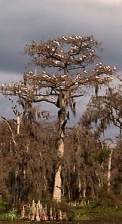Wakulla
Springs State Park
The River
Time Forgot
Wakulla
Springs, FL
January 15, 2000
I  can remember
sitting in the theater in the town where I grew up, watching the
old Sci-fi movies about the dinosaur period. All those old spooky
swamps with the strange and dangerous creatures lurking just
under the surface of the murky water as some hero desperately
tried to gain ground on the specific monster that had captured
the heroine. Afterwards I would day dream about
can remember
sitting in the theater in the town where I grew up, watching the
old Sci-fi movies about the dinosaur period. All those old spooky
swamps with the strange and dangerous creatures lurking just
under the surface of the murky water as some hero desperately
tried to gain ground on the specific monster that had captured
the heroine. Afterwards I would day dream about  going to
such a land and drifting down one of those neat still water
channels with all the creatures around me. Of course I never
really planned on doing that, but then some 50 year later, I was
afforded an opportunity to fulfill this small fantasy. It
started, most innocently, with Laura, as usual, handing me a
small non-descriptive brochure for one of Florida's less known
secrets.
going to
such a land and drifting down one of those neat still water
channels with all the creatures around me. Of course I never
really planned on doing that, but then some 50 year later, I was
afforded an opportunity to fulfill this small fantasy. It
started, most innocently, with Laura, as usual, handing me a
small non-descriptive brochure for one of Florida's less known
secrets.  Wakulla
Springs State Park in Wakulla Springs. The picture on the front
of the brochure said it all, a disappearing trail of water
through a green lush landscape with a myriad of creatures all
about. It was as if it beckoned out of my past. Ah, but enough of
the romantic -- on with the reality. We pulled into Wakulla
Springs State Park and drove directly to the lodge. Behind the
lodge was a piece of property which was, to say the least,
priceless. Absolutely crystal clear water slowly flowing out
through a pristine landscape of trees, ferns, moss and wildlife.
In order to
Wakulla
Springs State Park in Wakulla Springs. The picture on the front
of the brochure said it all, a disappearing trail of water
through a green lush landscape with a myriad of creatures all
about. It was as if it beckoned out of my past. Ah, but enough of
the romantic -- on with the reality. We pulled into Wakulla
Springs State Park and drove directly to the lodge. Behind the
lodge was a piece of property which was, to say the least,
priceless. Absolutely crystal clear water slowly flowing out
through a pristine landscape of trees, ferns, moss and wildlife.
In order to  understand
the natural wonder of this place it was necessary for us to take
one of the guided boat tours. Our guide was a delightful man who
helped immensely in building this story. Ranger Bill Boydston,
who had been with the park for the last eight years. Bill
explained that the natural beauty of Wakulla Springs evolved for
the most part, as a result of its unique geologic history. For
millions of years, Florida was a shallow sea bottom.
understand
the natural wonder of this place it was necessary for us to take
one of the guided boat tours. Our guide was a delightful man who
helped immensely in building this story. Ranger Bill Boydston,
who had been with the park for the last eight years. Bill
explained that the natural beauty of Wakulla Springs evolved for
the most part, as a result of its unique geologic history. For
millions of years, Florida was a shallow sea bottom.  Over the eons, shells
from billions of small sea creatures accumulated on the sea
floor, slowly building a thick layer of rock called limestone.
This limestone formed the bedrock under Wakulla Springs State
Park today and contains the huge cave system which feeds the main
spring. He went on to explain that the St. Marks Limestone
Formation, as it is known, and the formations below it contain an
immense body of fresh water called the Floridan Aquifer System.
Over the eons, shells
from billions of small sea creatures accumulated on the sea
floor, slowly building a thick layer of rock called limestone.
This limestone formed the bedrock under Wakulla Springs State
Park today and contains the huge cave system which feeds the main
spring. He went on to explain that the St. Marks Limestone
Formation, as it is known, and the formations below it contain an
immense body of fresh water called the Floridan Aquifer System.
